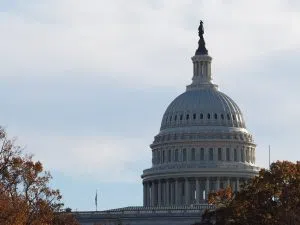
Fire investigators evaluated the scene on Oct. 9, 2024, of a fire that occurred Oct. 5, 2024, near New Town. (Provided by Office of the State Fire Marshal via the North Dakota Monitor)
(Amy Dalrymple – North Dakota Monitor) – Heat from natural gas flares combined with high winds and dry vegetation caused two of the October wildfires in western North Dakota, according to the state fire marshal.
Investigations into an Oct. 5 fire near Keene and a fire the same day near New Town found that both originated with flares at oil and gas wells next to agricultural land with stubble or dry grass, according to investigative reports.
The McKenzie County fires occurred in the hours before state regulators asked operators to voluntarily shut down oil and gas wells in areas with high fire danger, according to the investigative reports and an interview with Department of Mineral Resources Director Nathan Anderson.
The North Dakota State Fire Marshal is finalizing investigative reports on wildfires in Williams County, including one that claimed two lives and injured six. The U.S. Forest Service is investigating the Elkhorn Fire in McKenzie County and the Bureau of Alcohol, Tobacco and Firearms is investigating the Bear Den Fire on the Fort Berthold Reservation.
A total of 190 fires occurred in North Dakota in October, burning 126,273 acres, according to the state Department of Emergency Services. Damage estimates are still being compiled, but so far rural electric cooperatives report an estimated $7.7 million in damages, said Department of Emergency Services spokeswoman Alison Vetter. That would not include losses to farmers and ranchers.
McKenzie County fire crews received a report shortly after 3 p.m. Oct. 5 of a rapidly spreading fire near Keene. It ultimately burned 7,000 acres. About 5:30 p.m. that day, New Town fire crews were dispatched to another wildfire that resulted in damage to more than 2,000 acres. Both occurred near oil sites and the fires are referred to in investigative reports as the Midnight Run fire and the Dinwoodie fire – named after the oil wells.
Homes near both fires were evacuated as a precaution. No structures were lost and no injuries were reported.
To evaluate the cause of the fires, investigators examined the scene, interviewed witnesses and reviewed data including weather information. Wind gusts in the region were as high as 60-70 mph at times.
The North Dakota State Fire Marshal classified both fires as accidental. The reports rule out other causes and conclude that the high winds influenced the ignition and the spread of the fire. The reports note the conclusions could change if additional information is provided.
The New Town fire originated next to a Hess Corp. site with five oil and gas wells and a flare stack that a witness said was about 300 feet from the burned area, according to the report.
Operators are required to keep flares lit at oil and gas wells to prevent venting of natural gas. If a well is shut in, there is no need for a flare.
The report on the New Town fire said the normal temperature from the flare pilot ranges from 1,200-1,800 degrees Fahrenheit, according to information provided to investigators. A Hess Corp. representative told investigators the pilot temperature was slightly higher that day, the report says.
It’s possible for pressure spikes to occur with a flare stack that cause hot oil or carbon particles to be dislodged.
When investigators were on site on Oct. 9, the Hess flare stack had a sudden “burp,” causing the flare to get larger and black smoke to extend from the stack, investigators noted.
A Hess representative told investigators that one pressure spike was recorded the day of the wildfire but said it should not have caused hot oil to dislodge, the report says.
A Hess spokesperson said Wednesday the company was still reviewing the fire marshal’s report and had no immediate comment.

In the fire near Keene, a flare on a ConocoPhillips well site was about 53 feet from the origin of the fire, the report said.
The report notes three unsuccessful attempts investigators made to reach ConocoPhillips for an interview.
A ConocoPhillips spokesperson told the North Dakota Monitor on Wednesday the company is reviewing the fire investigation report and working directly with landowners and tenants. The company is committed to providing necessary information but was unaware of the interview request, the company said in a statement.
Anderson, who became North Dakota’s top oil regulator in September, said in an interview Wednesday the oil companies were operating in compliance with regulations.
Gov. Doug Burgum declared a statewide fire emergency the afternoon of Oct. 3, citing above-average temperatures, high wind gusts, low humidity and dry vegetation.
Anderson said he was notified late afternoon on Oct. 5 about the extreme fire danger conditions. Department of Mineral Resources staff worked quickly to contact oil operators and request they voluntarily shut down production in areas of high fire danger. He estimates those requests were relayed to operators by 6:30-7 p.m. that day and said companies complied with the request.
It appears that message came too late to have an impact on the two McKenzie County fires.
Anderson said the department formed a work group to evaluate what went right during the emergency response and what can be improved. The group has met three times and identified areas of improvement in communication, education and some administrative enhancements.
“Anytime you can make improvements, I think you should look at it, and we’re certainly taking this as an opportunity to do that,” Anderson said.
Keene Fire Chief Wade Signalness credited ConocoPhillips workers with actively helping crews fight the fire, including bringing tankers of water. But he hopes the industry as a whole evaluates what can be done to minimize fire risk during extreme weather.
“I think all oil companies can work together and figure out a solution when it comes to fires during high winds and dry conditions,” Signalness said. “We’ve got to do something. We owe it to the community.”
New Town Fire Chief John DeGroot said the fire season is projected to go into December and urged people to continue to be cautious.
“We’re still in the middle of fire danger,” DeGroot said.
The state has received an extension for filing for a presidential disaster declaration with a deadline of Dec. 5, according to the North Dakota Department of Emergency Services.
Jeff Beach contributed to this report.









